Natural Winner: Western Red Cedar and Nonresidential Building
An age-old favorite, this wood species supports a new wave of green building
![]() Continuing Education
Continuing Education
Use the following learning objectives to focus your study while reading this month’s Continuing Education article.
Learning Objectives - After reading this article, you will be able to:
- Describe the benefits of using western red cedar in terms of major green-building standards and forestry industry programs.
- List the main performance attributes of western red cedar and how they differ from other forestry products.
- Explain how red cedar materials were employed in a high school new construction projects, with details on assemblies and finish treatments.
- Discuss the kinds of western red cedar products available and their typical architectural applications, with attention to environmental benefits.
The use of natural materials in architectural projects is among the most valuable movements spawned by the green building industry. Sustainability is driven both by a reliance on the earth and long-term husbandry. The use of natural products, especially those that are renewable and durable, brings a cascade of benefits: Built environments tend to be healthier. Less pollution results. Occupants are less likely to experience allergies or chemical sensitivities. Energy is saved. And the beauty of nature is on display for all to enjoy.
One of the materials experiencing a recent renaissance of building use is western red cedar, a typical and widespread species in the Pacific Northwest. It is seen in an increasing number of green building projects, including institutional buildings like the award-winning Research Medical Complex of Barcelona, with its exterior lattice of 44,000 western red cedar boards, or commercial buildings like Brian Church Architecture's mixed-use, live-work SEMA 4 development in Leucadia, Calif., with its hull-like western red cedar exostructures.
The recently built Sandy High School in Sandy, Oregon, offers a highly valuable case study on why architects are using western red cedar for these kinds of large-scale gestures. The reasons are myriad, but include such considerations as environmental protection, building durability, and facility life-cycle cost.
This evergreen coniferous was once widely known as shinglewood—for its storied success in protecting Western homes and buildings. The species grows alone and amid stands of Douglas fir and western hemlock in forests, on mountainsides, and in wet lowlands from Vancouver Island and the Oregonian Pacific Coast to the Inland Empire areas reaching into Idaho. Ruddy brown in appearance, western red cedar (sometimes called “red cedar” or “western redcedar”) has a uniquely tight and straight graining pattern, typically with few knots. Its smell is memorable, yet architects and builders often favor Thuja for its inherent strength and high resistance to decay and rotting. In fact, this is partly due to its chemical makeup, which includes a natural fungicide, thujaplicin, that contributes to the aroma and persists in the timbers for decades after felling.
It adds up to a worthy cash crop, say experts in building materials. “Western red cedar is the most valuable species of the coastal forests and among the most appreciated architectural materials globally,” says Paul Mackie, a technical specialist and field representative for the Western Red Cedar Lumber Association (WRCLA), a trade group representing manufacturers and distributors. “First, it is the most stable of all softwood species, and one unique advantage of western red cedar is that it is extremely lightweight.”
 |
Sandy High School demonstrates commitment to sustainability and achieved LEED G old certification. It also met the local design standards. Photo by Josh Partee, courtesy of WRCLA |
Use of the wood, which is a traditional building material for residential applications, now extends around the world. In Australia and New Zealand, “western red” is favored for shutters, blinds, and window trims. For years it has been commonly used in the United Kingdom, Japan, the Netherlands, the Czech Republic, France, and Ireland, among other places. Recent projects have included a major U.S. big-box retailer, currently rolling out stores around the globe, from Mexico City and Chile to Europe and Russia, with a cladding of North American Thuja.
“The international exposure is amazing,” says Mackie, a former wholesale lumber executive whose family has had a legacy of involvement in western red cedar since 1895, and operated western red cedar shingle mills until 1963. “It's an effective choice for architects and building owners who want practically perfect wood. In most cases, one supplier can furnish whatever the project needs.”
 |
Western red cedar is commonly used for residential buildings, but it is increasingly used for commercial and institutional facilities. Photo courtesy of WRCLA |
Physical Properties and Image
Where a high degree of control is desired over a building's aesthetic and construction detailing—and over the availability of matching materials—architects and their clients have gravitated toward the consistency and predictability of lumber stocks like western red cedar.
There are other reasons, too, including brand image and institutional identity for some building owners, like the big-box stores now being built that must use the same wood cladding for locations around the world. Western red cedar has also become an emblematic material, carrying connotations of naturalistic luxury. Architectural styles including regional modernism, neotraditionalism, the Pacific Northwest, and mountain lodge styles of the American West are both marked by heavy use of the materials, and these trends have influenced architects elsewhere in the United States but also in Europe, Asia, and Australia.
Practical reasons to use western red cedar are as longstanding as the early U.S. buildings with original western red cedar timbers now more than a century old. They help explain western red cedar's historically heavy use in architecture and construction, too.
Dimensional Stability
Western red cedar is a low-density softwood with high resistance to shrinkage compared to other wood species. It is approximately twice as stable as commonly used softwoods. Western red cedar timbers also provide high relative thermal insulation ability (R-value) as compared with other woods and building materials.
Workability
Like many wood species, western red cedar can be worked with standard tools for cutting, forming, and joinery, according to Edmund A. Allen Lumber Co., which specializes in the species. Standard carpenter glues and joining methods work well with western red cedar, and the species can accept any typical wood finish. Because of its low density and low shrinkage factors—as given by the American Softwood Lumber Standard, PS 20-70—western red cedar tends to lie flat and remain straight longer than other softwoods and some hardwoods. It can be nailed and screwed easily when attached to the structural members of a building using high-quality corrosion-resistant fasteners.
Finish Compatibility
Western red cedar, according to Edmund A. Allen, “though rich in extractives, is free of the pitch and resin found in other softwoods, making it ideal for a wide range of finishes.” This includes lightly toned clear solutions, semi-transparent stains, and two-coat solid colors. The lumber company contends that, “Western red cedar ranks at the top in its ability to accept and maintain a finish.”
Weight and Density
Western red cedar is also one of the lightest commercial softwoods, due to its cellular structure. It averages about 12 percent moisture content and weighs approximately 23 lb. per cubic foot, with a relative density (specific gravity) of 0.32 as compared to yellow pine at 0.42, walnut at 0.65, and oak (0.6 – 0.9)1 Western red cedar's light weight and low density make it easier to handle and more economical to transport than some alternative materials.
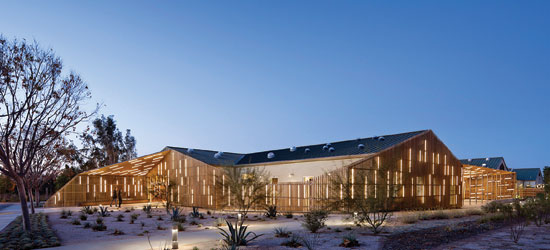 |
Western red cedar is a very stable softwood that is also lightweight and affords a high degree of control if desired over a building’s aesthetic and construction detailing. Photo courtesy of CUC Admin Campus Center, LTL Architects |
Natural Preservative
Western red cedar naturally resists moisture, rot, and damage from termites and other pests due to its thujaplicin content and other inherent attributes of the wood. For this reason, it is ideal for cladding, roofing, fencing, decks, and any architectural applications. Compared with the plastic composites used for decks, boardwalks, and rooftop platforms, cedar is often a comparable choice. “Creating plastic in the first place requires far more energy usage than it takes to harvest a tree,” according to WRCLA. “Plastic also comes from nonrenewable resources, while trees are replanted and grow back. And plastic breaks down very slowly, while timber is biodegradable.”
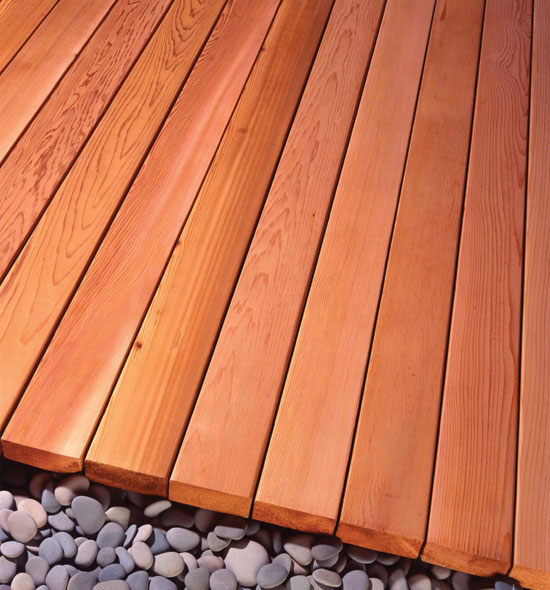 |
Western red cedar naturally resists moisture, rot, and damage from termites and other pests due to its thujaplicin content and other inherent attributes of the wood. Photo courtesy of WRCLA |
Fire Safety
Western red cedar exceeds minimum safety classifications for such measures as flame spread and smoke-development ratings, often without any preservatives or added retardant chemicals.
In addition, the track record for cedar around the world demonstrates that the lumber holds its architectural and structural properties extremely well, even after decades of exposure to sun, rain, heat, and cold. This fact was among the top considerations given for its extensive use at Sandy High School, designed by the firm Dull Olson Weekes–IBI Group Architects, which hadn't used the material on its previous nonresidential projects.
Sustainability: Supply and Resources
Sustainability was another major consideration for Sandy High School, as it is with many projects that employ western red cedar. The architects had designed a number of LEED Gold high schools, including one meeting the criteria for the Living Building Challenge, a rigorous performance standard created by the International Living Future Institute. The firm—which works out of LEED Platinum office interiors it designed in Portland, Oregon's historic Federal Reserve Building—is known for its sustainability action plan and for efficient, green works.
Resource Extraction
Considering the environmental benefits of western red cedar begins with a look at material sources and extraction costs. According to WRCLA, “America grows 30 percent more wood each year than it harvests and has more forestland today than 100 years ago.” Mackie adds that the renewable material comes almost exclusively from “sustainably and responsibly managed forests” primarily in British Columbia, with a considerably smaller fraction from Idaho and Northern Oregon. While there is a harvest in Washington State, says Mackie, that stock is almost entirely used for fence boards.
“About 95 percent of the forestland in British Columbia is owned by the province and operated under management contracts—tree farm licenses, or TFLs—for large blocks of timberland,” says Mackie. “Of those forests, more than 85 percent of the operations are third-party certified as sustainably managed.” About two-thirds of the forests are certified by the Canadian Standards Association (CSA) Group Sustainable Forest Management (SFM) System. Of the remaining third, most is certified by the Sustainable Forestry Initiative (SFI) with a small slice of about 5 million acres (2 million hectares) certified by the FSC, the Forest Stewardship Council.
Summing up, Canadian western red cedar sourced for a building project is very likely to be certified; in the United States, certified product is also readily available. Overall, only a sliver of the lands are harvested on an annual basis—in Canada, less than 0.33 percent—and, says Mackie, “Forests are replanted immediately and replanted in kind, meaning that they have to replant exactly the same proportion and mix that came off the land, and the same way it flourished.” Western red cedar thrives in the shade and also grows on mountains and riverbanks, yet in the coastal forests of British Columbia it may account for only about 25 percent of the species mix. On Vancouver Island, for example, the timber stand is about 60 percent western hemlock, and the balance divided evenly between fir and western red cedar.
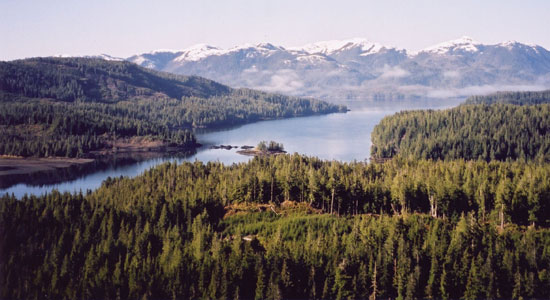 |
About two-thirds of the forests producing western red cedar are certified by the Canadian Standards Association, and most of the rest are certified by other organizations. Less than one-third of 1 percent of the lands are harvested annually. Photo courtesy of WRCLA |
Forest Management
Forest management and harvesting practices have advanced significantly, according to the CSA, which says it certifies more forestland than any other group. CSA released the SFM standard in 1996, and it is promoted through the Program for the Endorsement of Forest Certification, or PEFC. Certified lands must follow six criteria, including:
• Recognition of environmental, economic, social, and cultural values.
• Conservation of biological diversity.
• Ongoing public participation.
For specifiers and buyers of western red cedar, this means significant advances in management practices and harvesting. For example, the average cut block is relatively small, at about 50 acres (20 hectares), and replanted in kind. Using variable retention techniques, forest operators leave clumps of trees across cut areas to provide corridors for habitat and to help prevent erosion. For steep mountainside cuts, most logging companies use helicopters for extraction rather than build roads, which are costly—in some cases, $1 million per mile—and cause soil disturbance and erosion.
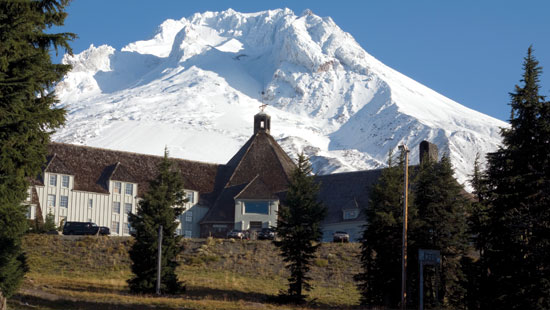 |
The “Sandy Style” municipal design standard used in Sandy, Oregon, is based on the regional Cascadian architectural style, epitomized by the Timberline Lodge. Photo by Jon Tullis/Timberline Lodge |
Best practices in replanting are also employed to promote biological diversity and environmental balance. In addition, newly planted saplings of two to four years old are protected with a wire-mesh cage to prevent deer and elk from damaging the tender, delicate foliage. Protections for social and cultural values include protecting any mature cedar tree or stand that is culturally modified, meaning for example that bark has been stripped for basketry or clothing, or if the tree is deemed a religious artifact. Because the native tribes are using the trees, the area is set aside, with a buffer left around the zone with evidence of cultural use. Similarly, key species are protected with a buffer; so if a bear den is found, for example, the area is protected.
Life-Cycle Considerations
For projects like Sandy High School, these best practices in forest management and conservation may seem distant and exotic, even though they contribute to LEED certification and other green standards. More immediate, however, are questions about green building that affect the occupants, the learning environment, and the long-term fiduciary obligations of the school district. Of increasing urgency, for example, is the use of life-cycle assessment (LCA) and cradle-to-cradle analysis, which “addresses major environmental impacts throughout the complete life cycle of a product, from extraction of raw materials, the processing of those materials, manufacturing of the product, transportation, use and final disposal, reuse or recycling,” according to environmental consultant Joel Ann Todd. Under LEED v4, she adds, credits will increasingly support a life-cycle approach in building material choices, particularly in the Materials & Resources (MR) category.
LCAs and EPDs
In recent life-cycle comparison studies, says Mackie, western red cedar compared favorably with vinyl decking and composite decking, as well as in vertical applications as siding when compared to brick, vinyl, fiber-cement, and other materials. The independent LCA study, undertaken by the Canadian forest products researcher, FPInnovations, showed that the use of renewable western red cedar “produces fewer greenhouse gases, generates less water and air pollution, [and] requires less energy to produce than alternatives.” These studies will benefit buildings projects, as will an Environmental Product Declaration (EPD) “or another approved form of reporting that discloses the required LCA-based information,” says Todd, and can be provided by the manufacturer. Mackie adds that EPDs have been available for western red cedar siding and decking products since April 2011.
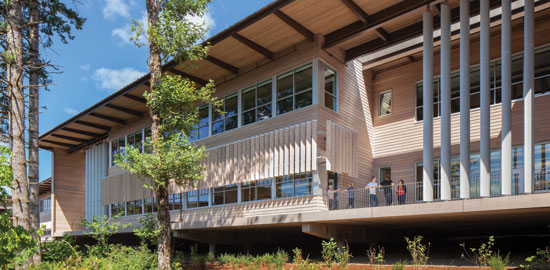 |
The balcony fins of western red cedar create a memorable image for the exterior of Sandy High School, designed by the firm Dull Olson Weekes–IBI Group Architects. Photo by Josh Partee |
For recent institutional projects like Sandy High School and commercial works like the new six-story mixed-use building AVA Ballard in Seattle, which mixes western red cedar exterior panels with bright orange balcony guardrails, life-cycle performance was essential. But so was installed first cost, a sum of “initial expenditures involved in capitalizing a property, [which] included such items as transportation, installation, preparation for service, as well as other related costs.”2 “In both cases, the architects and owner groups had limited experience with western red cedar, but they wanted to achieve a certain look,” says Mackie, who consulted on behalf of WRCLA Architectural Advisory Services. “And when initial cost data was submitted for the exterior skins, they found western red cedar to be surprisingly affordable compared to other materials.”
Case Study: Sandy High School
Other lessons can be learned about the use of western red cedar in the conception, design, and construction of Sandy High School. The project stands in the town of Sandy, located about 30 miles east of Portland, Oregon, on what was once the Oregon Trail. The relatively small community of fewer than 10,000 residents, which has long billed itself as the “Gateway to Mount Hood,” has long counted its regional history and rural character as essential parts of the collective local identity.
To make sure that this ethos was reflected in the town's nonresidential buildings, in 2008 town officials in Sandy codified the “Sandy Style,” a municipal design standard that expressed its underlying goal to “protect and enhance the city's quality of life and community image.” Specifically, the design guidelines aim to “express elements of or reflect Cascadian architecture by adapting appropriate elements of English Arts and Crafts Style (1900-1920) and Oregon Rustic Style (1915-1940) … into new buildings and exterior remodels.”
Local Design Standards. In drafting the code with input from area residents, Sandy officials also sought to “encourage green building practices in new construction” and to discourage “box-like structures with large, blank, unarticulated wall surfaces.”3 Though short of a pattern book, the design standard alludes to specific stylistic dimensions of the region's vernacular, including:
• Steeply pitched roofs and gables.
• Strong base materials using stone, block, or brick.
• Exposed heavy timbers or natural wood beams, posts, and trim.
• Use of warm earth-tone paint colors or brick, or both.
• Articulated building facades with prominent covered entries.
• Windows to allow viewing into the building.
• Public gathering spaces.
• Pedestrian focused site layout, parking and vehicle access.
The town has required compliance with Sandy Style design guidelines for new construction, replacements of structures destroyed by fire, additions to existing buildings, and site improvements such as landscaping, parking and civic spaces.
The Sandy Style seemed an ideal touchstone for a new, public high school to replace a 90-year-old facility that had outlived its usefulness. Contracted to design this major project, Portland-based Dull Olson Weekes-IBI Group Architects (DOWA-IBI)—known nationally for designing major secondary-school facilities—embraced the challenge of conceiving a building with a contemporary yet regionally appropriate aesthetic that would reflect and conform to the Sandy Style rules. Given that the use of the new code was somewhat untested in the context of a large, civic building, DOWA-IBI Group principals took their cue from the celebrated Timberline Lodge, which sits on nearby Mount Hood, in the Cascades, about 30 miles east of Sandy.
(As background, Timberline Lodge was a WPA or Works Progress Administration project, and its construction began in 1936 and was completed in 1938, shortly after a September 1937 dedication ceremony led by President Franklin D. Roosevelt. The lodge, which remains a model of the Cascadian architecture that was popularized in the Pacific Northwest during the early part of the 20th century—and whose exterior Stanley Kubrick used to establish the character of the Overlook Hotel in his classic 1980 film The Shining—was designated as a National Historic Landmark in 1977. It remains an iconic example of the architectural style residents of Sandy sought to codify in 2008. Built primarily using regionally harvested timber, Timberline Lodge was the Pacific Northwest's answer to the traditional alpine architecture of Europe.)
Durability and Maintenance. Even with such inspiration, Jerry Waters, a senior design architect with DOWA-IBI, points out that many officials charged with building a new $85 million school would likely shy away from a wood exterior over concerns about its long-term durability and maintenance costs. Understanding what residents of Sandy want to achieve in terms of the look and functionality of their public buildings, Waters and his colleagues convinced the town and school district leaders that western red cedar, used in conjunction with brick and precast concrete, could be “very economical,” in addition to giving the new high school the desired aesthetic.
The design concept included heavy-timber western red cedar frames and uncoated western red cedar board siding in a modern Cascadian interpretation. The roofline is pitched, as local rules request, and the massing is decidedly asymmetrical. Winglike clerestory skylights merge with an innovative collage of western red cedar slats, horizontal western red cedar cladding, and a heavy timber portico. To further adhere to the newly adopted Sandy Style, DOWA-IBI designed the 310,000-square-foot building to be empathetic to its context not only in color and materiality but also to “fit into the landscape” rather than interrupt it. As reported by Cliff Pearson in Architectural Record, Waters and his colleagues “broke the mass of the building into a number of pieces and tucked them into the sloping, wooded site.”
“The building needed to live in nature, just as the people around here do,” said John Weekes, AIA, a principal with DOWA-IBI Group, in an interview about the project. He has also said that architecture is, “about the human experience, the thing that makes people say, 'I want to be here.'”
In addition, the building had to be green: Waters says that sustainability was and remains a “very high priority” to residents of Sandy. The architects and their team of consultants (see sidebar “Integrated MEP Design,” next page) then developed a whole-building sustainability plan incorporating a long list of green building strategies. The overall goal was to “reduce the school's carbon footprint and tie it to the environmental ethos of the Pacific Northwest,” and in the process achieve a LEED certification of Gold.4
By designing a four-story facility organized along perpendicular axes that follow the site's hillside topography, Waters and his colleagues limited the amount of excavation that would have been required for a more conventional high-school siting approach. This one move also reduced site-preparation costs and oriented the building in a way that would improve energy performance while reducing operating costs. The inclusion of the clerestory skylights, solar panels, and rainwater-collection system contribute to the building running 54 percent more efficiently than energy-use guidelines set forth by the U.S. Environmental Protection Agency (EPA) for comparable educational facilities.
Specifying Western Red Cedar for a School
Having looked at examples of buildings whose original western red cedar exteriors had stood the test of time, the team at DOWA-IBI was confident that they could achieve the desired look without burdening the local school district. In fact, they considered the facility's timber exterior to be one of its long-lasting, low-maintenance building products, which would require little if any annual maintenance. Among the reasons is the wood's low density and minimal shrinkage factor, which improve the dimensional stability of the slats, boards and timbers. This means the members lie flat and remain straight after installation and hold fasteners solidly for years after construction.
The façades' durability also stem from western red cedar's natural resistance to moisture, decay and insect damage. “Western red cedar fibers in the heartwood contain natural preservatives that are toxic to decay-causing fungi,” says WRCLA's Mackie, who consulted to the project. “The two principal extractives that are responsible for the decay resistance are Thujaplicans and water-soluble phenolics.” He adds that a western red cedar tree's ability to produce these extractives increases with age, making the outer regions of heartwood the most durable.
According to DOWA-IBI's Waters, one of the key decisions to maximizing durability and minimizing maintenance was to treat the western red cedar with bleaching oil to accelerate the aging process and give the timber the grey, weathered appearance that has become associated with the Cascadian style—and as opposed to the honey color of stained western red cedar. Waters explains that WRCLA was helpful in providing information about treating the wood with bleaching oil and setting up that operation for their construction project.
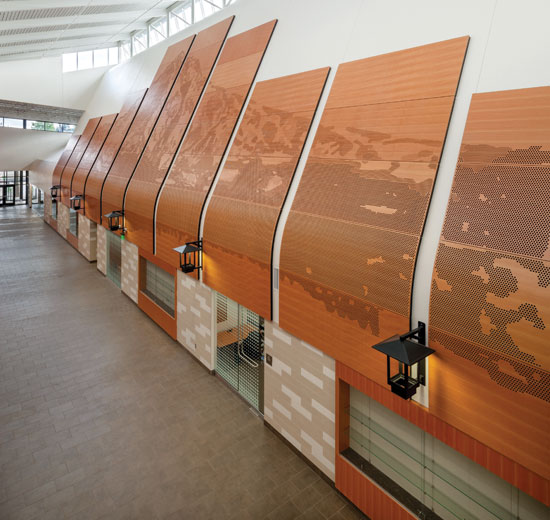 |
The interior of Sandy High School displays a mural of Mount Hood made of western red cedar. Photo by Josh Partee |
The low density of western red cedar, which helps provide its “exceptional thermal insulation value,” says Mackie, as well as the “natural preservatives that resist moisture, decay and insect damage,” were calculated into the decision to specify the species. The DOWA-IBI's envelope design further built upon these capabilities by including an air cavity behind the building's skin, which provides ventilation and keeps the enclosure dry.
Much of the western red cedar used for the project came from Idaho and Canada, says Steve Schellhase, president of Portland-based Time Frame, Inc., which framed and sided the Sandy High School building. The amount of western red cedar required to build the school precluded contractors from using materials sourced from certified forests, he said. On the project site, one of the big challenges for Schellhase was the heavy timber framing required for the enclosure massing, including its sawtooth roof and shade-giving 12-foot overhangs and louvers. Each western red cedar column comprises four, 8-by-8-inch cedar posts, supporting double 8-by-18-inch beams and double 8-by-16-inch rafters, all of which run in tandem.
Methods and Materials for Western Red Cedar
The bleaching-oil treatment, which was applied by Northwest Coating Systems in Woodburn, Ore., was an approach that Schellhase had never seen employed. The timber was sent directly from its sources—primarily in Idaho—to the mill and then to the treating company, where the pieces were dried and coated. Once the materials arrived on site, Schellhase and his team followed “heavy timber industry standards” including the American Wood Council (AWC) guide, Heavy Timber Construction.5 While the techniques originated for use in industrial and storage structures, they are commonly used for schools, auditoriums, gymnasiums and other assembly buildings.
Integrated MEP Makes Sandy High Greener According to Interface Engineering, which provided a raft of mechanical, electrical and plumbing (MEP) and sustainability services for the Sandy High School project, a whole-building integrated design strategy led to the green building choices behind it, including the use of western red cedar. The school uses several nontraditional techniques for maximizing whole-building efficiency and reducing energy needs. One is a geoexchange system, which has underground water pipes buried below the new athletic field. These “allow access to the earth’s relatively constant temperature—50 degrees) for free heating and cooling,” according to Interface Engineering. In fact, the closed-loop system of pulling and rejecting heat, in addition to the heat recovery chiller, may meet all of Sandy high school’s HVAC demands throughout the year, given typical weather. The school also employs radiant heating and cooling slabs in areas such as the cafeteria, auditorium, library, and entrance lobby. Enhancing the schools indoor environmental quality (IEQ) is a displacement ventilation system in the classrooms and learning areas.The building management systems use CO2 measurements to operate a demand-controlled ventilation system, which further reduces HVAC and energy use. On the roof, a 40-panel solar thermal hot-water heating system also saves energy. A solar panel array totaling 144 kilowatts supplies free electricity, and may be expanded in the future. According to the architects and engineers, some of the energy-saving systems were offset by a $600,000 incentive from the Energy Trust of Oregon. |
Time Frame also hired quality carpenters and craftsmen to cut and assemble the Sandy High School panels and boards—several hundred thousand feet of which now make up the building's beams. The decking and siding each required another 100,000 feet of timber. A minimal amount of bleaching-oil treatment was done on site, around cut-ins and where touch-up work was needed.
The building's laminated deck consists of three layers—two pine and one western red cedar—pressed and glued together. The roof overhangs were constructed as panels and lifted into place, which saved time and made installation safer and easier than building them in place. The use of western red cedar may not have added to the work of a project of this nature, but it required a demanding combination of specialized materials, treatments and architectural detailing that are unlike a typical lodge or residential structure. For those reasons it may have required more labor hours than a typical building of comparable size, Schellhase says, “But the result is a totally unique project,” and it brings to the fore new ideas for the extensive use of western red cedar. “It's not something you see a lot of,” he adds.
Yet the project design team expects to see more commercial and institutional applications of western red cedar. While in some cases using western red cedar may be more costly than some typical materials used in educational construction, such as concrete masonry units or cast-in-place concrete, Schellhase and Waters point out that conforming to the Sandy Style as the design-and-construction teams did would have been difficult with another material. And in the end, the western red cedar exterior is expected to last a long time, given DOWA-IBI's innovative design, which the American Institute of Architects recognized in August 2013 with an Educational Facility Design Excellence Award. In its press release, the AIA said the building, which is LEED Gold-certified, “sets very high standards in terms of materials, finishes and aesthetics.”
The high LEED certification demonstrates the range of benefits of using western red cedar. The WRCLA summarizes that cedar has the “lowest environmental impact when compared with other materials such as brick and fiber cement.” Both Waters and Schellhase are confident that the school's exterior, beams, and decking will last as long as the building's anticipated service life, and won't require refinishing any time soon.
Lessons Learned
In fact, western red cedar is one of the few wood species that are naturally at home in the outdoors, making them ideal for these kinds of structural and decorative exterior applications. “Properly finished, western red cedar will last for decades, even in harsh environments. Its natural resistance to moisture, decay and insect damage make it the ideal choice for a surface that is exposed to sun, rain, heat and cold all year round,” according to a WRCLA guide.
A range of western red cedar products that goes well beyond those specified for the Sandy High School project are now on the market, providing for a variety of potential applications. Western red cedar timbers may have clear or knotty grades with smooth surfaced, combed or rough sawn finishes; kiln dried or unseasoned (green); flat grain and vertical grain. Products and applications include:
• Siding & trim, with precut and seasoned panels and trimboards, includingbevel, tongue & groove, lap and board-and-batten type claddings.
• Structural decking, outdoor decking, fencing, pergola kits, and other outdoor lumber systems.
• Indoor materials, including grades for cedar paneling and moldings.
• Timbers of various grades, sizes and fasteners for western red cedar timbers.
For nominal widths, thicknesses and grades of some commonly available western red cedar lumber products, specialized suppliers and the WRCLA provide information and technical data. Western red cedar produced by some of the suppliers includes specialty end-use grades as well as products graded to National Lumber Grading Authority (NLGA) rules. NLGA grades are approved by the American Lumber Standards Board of Review and are accepted under all U.S. building codes.
Clear western red cedar (clear grades) have a limited number of natural characteristics and is specified when high-quality appearance is desired. These timbers are normally supplied green, or unseasoned, and may be seasoned using air-drying, as needed. Knotty grades present a more rustic appearance and are typically supplied green in the appearance and structural grades. When required, seasoning is achieved by air-drying except for grades used for light framing and for structural joists and planks, which are available kiln-dried.
Surface textures employed for architectural effect include saw textured, which is obtained during the milling process using either a circular or band saw. The effect appears on the face of the lumber. Rougher headed is the description of lumber that receives its rough texture from a milling process in which roughened planer knives are used; again, it is seen on the face. Often these products are furnished S1S2E- (Surfaced 1 side, 2 edges), with a saw textured rougher head face. Often these products are reversible. Last, the designation surfaced four sides, also known as S4S, presents a smooth appearance on four sides and a very uniformly sized product with a high quality appearance. These architectural-quality surfaced textures are available in siding and trim in 1”, 5/4” and 2” thicknesses and in timbers 4” thick and larger. Larger sizes are readily available, but may need to be special ordered.
Fasteners used with western red cedar include wide-diameter hardware of hot-dipped galvanized, aluminum, and stainless steel, which are all corrosion resistant. Other types of nails are not recommended, says WRCLA's Mackie, due to poor performance from rusting and adverse reactions to the otherwise beneficial natural fungicide, thujaplicin, which provides the wood's inherent strength and high resistance to decay and rotting. The chemical reactions may also lead to staining and streaking that is visible to building occupants or visitors. (This includes copper nails.) No. 304 stainless-steel fasteners tend to work very well for general applications, especially if the wood is to be finished with transparent or semi-transparent stain; for coastal and corrosive environment, No. 316 stainless steel is effective.
For heavy-timber construction as used at Sandy High School, typical connectors used include carriage bolts, lag screws, split rings and shear plates, and custom made hardware assemblies. Mechanically fastened joints must consider dimensions for end spacing and edge spacing, as well as product moisture content. WRCLA notes that fabrication and installation costs make up the lion's share of the budget for a heavy timber structure, so it is important to engineer the details of the structure before designing the timber members.
A last but important consideration is finish choice and application. Opaque finishes such as paint provide a high degree of surface protection for any lumber against weathering and wetting. However it does conceal some of the wood's characteristics. Natural finishes are highly desirable and generally require some level of regular maintenance to optimize the product's appearance and life-cycle performance. Transparent stains that modify the color or tone of the wood, for example, are available in waterborne and solvent-borne formulations, but unpigmented or lightly pigmented finishes provide limited protection against the sun's ultraviolet light and moisture related damage. Frequent refinishing is recommended, and it is an easy process for transparent stains, demanding only minimal surface preparation.
According to WRCLA, solvent-borne, oil-based semitransparent penetrating stains are ideal for western red cedar. These formulations penetrate the wood surface and are porous, so they lack the surface film created for example by paints. These stains perform best on western red cedar with a textured surface; in all cases they protect the cedar surface from damaging UV effects. A typical service life on siding applications may vary from three to six years depending on the western red cedar surface texture, quantity of stain applied, and the intensity of the sunlight on the wood surface.
In addition, latex semitransparent stains may appear similar to solvent-borne stains, but the latex product tends to be a thin film with little penetration into the wood. It may not be thick enough to provide the same durability as solvent-borne stains and has been known to degrade by flaking from the wood's surface. Much more substantial surface preparation is required for refinishing when using the latex products. “However, as increasingly restrictive environmental standards reduce the availability of solvent borne stains, ongoing research suggests that penetrating, erodible latex semi-transparent stain finishes for western red cedar will be available in the near future,” according to the Western Red Cedar Lumber Association.
In general, any rules applicable to good wood finishing will apply to western red cedar. Plan for regular maintenance of outdoor wood finishes. Specify proper surface preparation so that the contractors achieve a durable, long-lasting exterior finish. Application of finishes is likely to be just as important as the finish-substrate combination chosen for the red cedar surfaces. In fact, many factors influence finish performance and life-cycle, including the unique properties of western red cedar and manufacturing characteristics and construction practices used for each building project.
These factors are increasingly important for commercial and institutional buildings using western red cedar as part of their designs. With the varied products available and by using inventive combinations, architects like DOWA-IBI, Ankrom Moisan Architects, Inc. (which designed AVA Ballard near Seattle), and California's SEMA 4 see the use of western red cedar as an integral part of their design expression. It can also be the secret to good life-cycle performance—as well as a way to improve a nonresidential building projects' sustainability.
C.C. Sullivan is a marketing communications consultant specializing in architecture and construction.
Endnotes |
|
| 1. | http://www.engineeringtoolbox.com/wood-density-d_40.html |
| 2. | McGraw-Hill Science & Technology Dictionary (McGraw-Hill Dictionary of Scientific and Technical Terms) |
| 3. | City of Sandy website, http://www.ci.sandy.or.us/index.asp?Type=B_ BASIC&SEC={1D15D680-C1F5-42DE-A882-59ABB3EC8B11} |
| 4. | “Walk in the Woods,” Architectural Record, January 2013 |
| 5. | http://www.awc.org/pdf/wcd5.pdf |
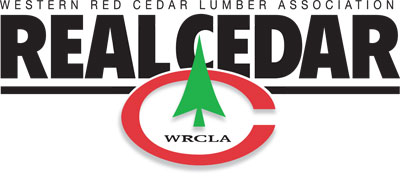 |
The Western Red Cedar Lumber Association is a Vancouver-based non-profit association representing 17 quality suppliers of Western Red Cedar lumber products in Washington, Oregon, and British Columbia (Canada). Founded in 1954 and known as “the voice of the cedar industry,” the WRCLA delivers market programs throughout the United States and Canada to support its members’ cedar products with information, education, and quality standards. www.realcedar.com |
